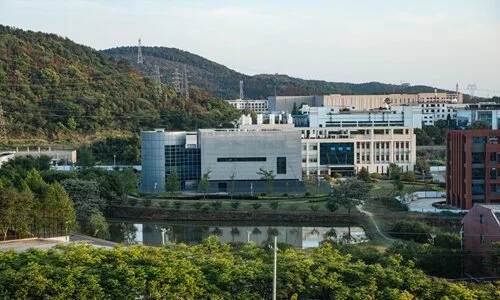Wuhan Labfest
May 17, 2020
THE VERY EXCITABLE Mail on Sunday parses a new study that raises the possibility that this increasingly tedious global pandemic could indeed have originated in a laboratory.
Biologists with the Broad Institute compared the various samples of SARS-CoV-2 with its 2002-3 predecessor and concluded that it was virtually fully-formed and “already pre-adapted to human transmission” when it was first identified in December.
The researchers told the newspaper that “the possibility that a non-genetically engineered precursor could have adapted to humans while being studied in a laboratory should be considered”.
Outside Huanan Seafood Market, Wuhan
The authors’ comments allow the Mail on Sunday to speculate that a staff member at the Wuhan laboratory, exposed to the virus for a long period of time and eventually infected by it, visited the Huanan seafood market at some point in December and released the “pre-adapted” SARS-CoV-2 into the wild, launching a global killing machine.
But that is just one of many hypotheses one could use to explain their findings. One could just as easily suggest that an individual of currently unknown origin was exposed to the new coronavirus in the wild, carried it until it mutated and then passed it on to a cluster of individuals at the market, a theory that seems to be supported by other studies.
Viruses mutate incredibly frequently. Out of the thousands of variants, it doesn’t seem to me to be particularly unusual that the one we identify first should appear to be “pre-adapted to human transmission”. It stands to reason that the virus we exhaustively study is the one that is, ipso facto, most “pre-adapted to human transmission”. After all, we have had no cause to monitor and scrutinize any number of near misses that might have occurred over the last few decades.
It should also be mentioned that some scientists reject the “human pre-adaptation” thesis altogether, claiming instead that the SARS-CoV-2 is instead a very versatile pathogen capable of infecting many numbers of species.
The scientific paper itself - which has not as I write completed its peer review - is far more circumspect, and does not make any direct allegations against the Wuhan Institute of Virology. It refers to the possibility of a “bottleneck event similar to the late epidemic SARS-CoV cases that stemmed from a single superspreader who visited Metropole Hotel in Hong Kong, China, in late February 2003.”
And it makes this concession:
… there is presently little evidence to definitively support any particular scenario of SARS-CoV-2 adaptation. Did SARS-CoV-2 transmit across species into humans and circulate undetected for months prior to late 2019 while accumulating adaptive mutations? Or was SARS-CoV-2 already well adapted for humans while in bats or an intermediate species?
The conclusion is as follows:
The lack of definitive evidence to verify or rule out adaptation in an intermediate host species, humans, or a laboratory, means that we need to take precautions against each scenario to prevent re-emergence.
Sunset in Wuhan
CHINA’S FOREIGN MINISTRY recently put out a long statement rebutting the “twenty-four lies” told by the United States about the coronavirus, including the role played by the Wuhan Institute of Virology, as well as allegations that China faked its case data, covered up the outbreak and deliberately allowed infected people to travel overseas and spread the disease to Europe and elsewhere.
As far as the lab is concerned, nothing will ever convince the conspiracy theorists, and a statement from the Chinese government saying “we didn’t do it” is clearly going to be the least convincing at all. China’s institutional aversion to transparency breeds suspicion: behind any wall of silence, one imagines all kinds of lurking demons. Still, few scientists will argue with the fact that the genetic structure of SARS-CoV-2 points to a natural origin, even though some still raise the possibility that it entered Wuhan’s bloodstream via the lab.
Every journalist knows what happens when one publishes a story that casts doubt on the idea that the coronavirus was manmade: one is subjected to the usual barrages of bollocks from a multitude of Internet randoms who presume to know better. Twitter lights up with sarcastic replies from people who are absolutely convinced that China manufactured a killer virus in a laboratory and unleashed it on the world via the crude transmission method of putting infected living bodies on aeroplanes.
“Apparently there were no bats served at the Huanan market…” Apparently this… Apparently that… It pays to be sceptical, but none of these people have a scintilla of an iota of a soupçon of corroborating evidence that the lab is involved, and prefacing each unproven claim with the word “apparently” simply doesn’t cut it.
And one additional problem is that they don’t just rely on natural paranoia to fuel their theories: they also deliberately fabricate evidence.
Myth-busting website Snopes drew our attention the other week to a viral email containing quotes attributed to Nobel laureate Tasuku Honjo, saying that the coronavirus was invented in the Wuhan laboratory and the people working there have since been murdered by the State.
Dr. Honjo was quoted as saying: “if it is not proven even after my death, take away my Nobel prize.” It was. needless to say, all completely fake.
Some people remain desperate for a Malign Actor. It isn’t enough to allege that China mishandled or delayed its response in the very early stages of this outbreak: as is becoming increasingly clear, similar arguments can be made about each and every government during this pandemic, and it is always easy to be wise after the event. It has also to be shown that Beijing was engaged in some sort of sinister chemical warfare operation or an act of criminal negligence that serves to implicate its “system” and its leadership.
JUST BECAUSE China is engaged in a cover-up doesn’t necessarily mean that the Wuhan biosafety lab is to blame. And even if the Wuhan biosafety lab isn’t to blame, that doesn’t mean China is off the hook. Thus, the U.S. also appears to be chasing another narrative. If you can’t blame the lab, blame the system.
Matthew Pottinger, a former foreign correspondent in Beijing who now serves as Donald Trump’s deputy national security advisor, believes China’s “catastrophic” handling of the coronavirus has made the entire world “the collateral damage of China’s internal governance problems.”
This prevailing Western consensus about China right now seems to go like this: the coronavirus crisis proves Beijing’s cyber-totalitarian governance model doesn’t actually work. It is perfectly suited to locking people down, but next to useless at preventing outbreaks in the first place because it seeks to circumscribe or misdirect the natural flow of information.
The theory, suggested by a range of anti-PRC pundits, is that the apparatchiks of Wuhan didn’t want to deliver bad news to their superiors and believed it would be easier to let it blow over. Concerned about the optics, China has since embarked on a disinformation campaign aimed at deflecting blame.
Beijing’s enemies argue that China’s political system is predisposed to sweep problems under the carpet. Many also argue that China’s attitude towards nature, derived perhaps from overpopulation rather than any underlying cultural or philosophical attribute, is also a decisive factor in this crisis. Is there another country so desperate to squeeze so much out of its ecosystem, or to monetise and commoditise every aspect of its natural wealth?
China’s response? With the world trying to throw whatever dirt it can at Beijing’s political system as well as its geopolitical motives, the response of the country’s state propaganda organs is that this outbreak could have happened anywhere, and might well have done. The message is: just because it was identified in China doesn’t mean it originated in China.
“Viruses do not distinguish between ideologies and social systems,” said the foreign ministry.








